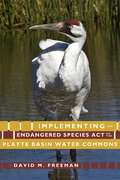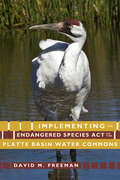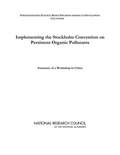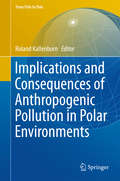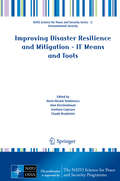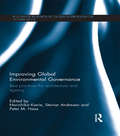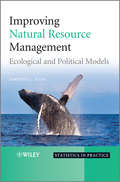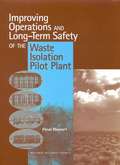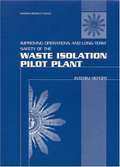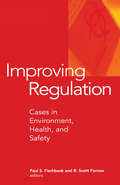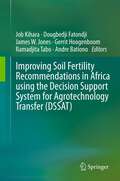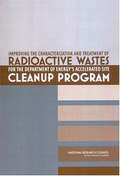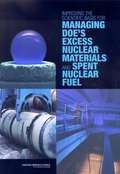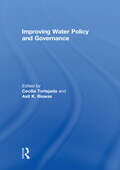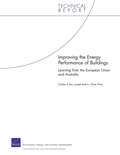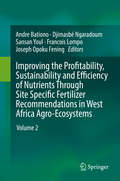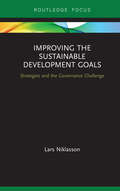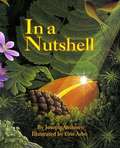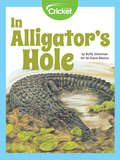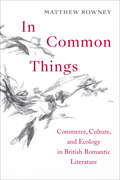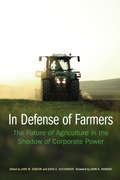- Table View
- List View
Implementing the Endangered Species Act on the Platte Basin Water Commons
by David M. FreemanWater users of the Platte River Basin have long struggled to share this scarce commodity in the arid high plains, ultimately organizing collectively owned and managed water systems, allocating water along extensive stream systems, and integrating newer groundwater with existing surface-water uses. In 1973, the Endangered Species Act brought a new challenge: incorporating the habitat needs of four species-the whooping crane, piping plover, least tern, and pallid sturgeon-into its water-management agenda. Implementing the Endangered Species Act on the Platte Basin Water Commons tells of the negotiations among the U.S. Department of the Interior, the environmental community, and the states of Wyoming, Colorado, and Nebraska that took place from the mid-1970s to 2006. Ambitious talks among rival water users, environmentalists, state authorities, and the Department of the Interior finally resulted in the Platte River Habitat Recovery Program. Documenting how organizational interests found remedies within the conditions set by the Endangered Species Act, describing how these interests addressed habitat restoration, and advancing sociological propositions under which water providers transcended self-interest and produced an agreement benefiting the environment, this book details the messy process that took place over more than thirty years. Presenting important implications for the future of water management in arid and semi-arid environments, this book will be of interest to anyone involved in water management, as well as academics interested in the social organization of common property.
Implementing the Endangered Species Act on the Platte Basin Water Commons (G - Reference, Information And Interdisciplinary Subjects Ser.)
by David M. FreemanWater users of the Platte River Basin have long struggled to share this scarce commodity in the arid high plains, ultimately organizing collectively owned and managed water systems, allocating water along extensive stream systems, and integrating newer groundwater with existing surface-water uses. In 1973, the Endangered Species Act brought a new challenge: incorporating the habitat needs of four species-the whooping crane, piping plover, least tern, and pallid sturgeon-into its water-management agenda. Implementing the Endangered Species Act on the Platte Basin Water Commons tells of the negotiations among the U.S. Department of the Interior, the environmental community, and the states of Wyoming, Colorado, and Nebraska that took place from the mid-1970s to 2006. Ambitious talks among rival water users, environmentalists, state authorities, and the Department of the Interior finally resulted in the Platte River Habitat Recovery Program. Documenting how organizational interests found remedies within the conditions set by the Endangered Species Act, describing how these interests addressed habitat restoration, and advancing sociological propositions under which water providers transcended self-interest and produced an agreement benefiting the environment, this book details the messy process that took place over more than thirty years. Presenting important implications for the future of water management in arid and semi-arid environments, this book will be of interest to anyone involved in water management, as well as academics interested in the social organization of common property.
Implementing the Stockholm Convention on Persistent Organic Pollutants: Summary of a Workshop in China
by National Research Council of the National AcademiesThis report summarizes a workshop --- Strengthening Science-Based Decision-Making: Implementing the Stockholm Convention on Persistent Organic Pollutants held June 7-10, 2004, in Beijing, China. The presentations and discussions summarized here describe the types of scientific information necessary to make informed decisions to eliminate the production and use of Persistent Organic Pollutants (POPs) banned under the Stockholm Convention, sources of information; scientifically informed strategies for eliminating POPs, elements of good scientific advice, such as transparency, peer review, and disclosure of conflicts of interest; and information dealing with POPs that decision makers need from the scientific community, including next steps to make such science available and ensure its use on a continuing basis.
Implications and Consequences of Anthropogenic Pollution in Polar Environments
by Roland KallenbornThe first evidence on the adverse effects of organic pollutants on Arctic ecosystems was provided by international research initiatives more than 30 years ago. Today, the indigenous people of the North are considered to be affected by exposure to persistent organic pollutants (POPs) and metals through their traditional marine food sources. The occurrence of pollutants of emerging concern in remote Polar environments is considered an essential criterion for prioritising this (largely neglected) type of contamination in national, international and global regulation schemes. Initiated during the first international Polar Years (IPY 2007-2009) and continued afterwards, 11 representative initiatives and projects are summarised as chapters in this book, which highlights today's interdisciplinary research on POPs in the Polar environment. The individual chapters describe in detail the consequences, priorities and perspectives of international research on POPs (legacy and emerging xenobiotics), its implications for regulations and scientific priorities including societal and cultural developments in the Arctic, as well as conservation priorities in Antarctica. This book is intended for all readers interested in learning more about modern research on environmental pollutants in the Polar environments (with a strong focus on Arctic environments). The impacts of pollution and climate change on Polar regions and the world as a whole will continue to be felt for many years to come. Sound science is, thus, vital in order to underpin actions that need to be taken at the global, regional and local levels. This book contributes to this highly relevant, interdisciplinary environmental scientific endeavour.
Imported Oil and U.S. National Security
by Keith Crane Stuart E. Johnson Michael Toman Andreas Goldthau Thomas LightIn 2007, the United States imported 58 percent of the oil it consumed. This book critically evaluates commonly suggested links between these imports and U.S. national security and assesses the economic, political, and military costs and benefits of potential policies to alleviate imported oil?related challenges to U.S. national security.
Improving Disaster Resilience and Mitigation - IT Means and Tools
by Horia-Nicolai Teodorescu Alan Kirschenbaum Svetlana Cojocaru Claude BruderleinThe focus of this volume is comprised of the fundamentals, models, and information technologies (IT) methods and tools for disaster prediction and mitigation. A more detailed list of topics includes mathematical and computational modeling of processes leading to or producing disasters, modeling of disaster effects, IT means for disaster mitigation, including data mining tools, knowledge-based and expert systems for use in disaster circumstances, GIS-based systems for disaster prevention and mitigation and equipment for disaster-prone areas. A specific type or class of disasters (natural or human-made), however will not be part of the main focus of this work. Instead, this book was conceived to offer a comprehensive, integrative view on disasters, seeking to determine what various disasters have in common. Because disaster resilience and mitigation involve humans, societies and cultures, not only technologies and economic models, special attention was paid in this volume to gain a comprehensive view on these issues, as a foundation of the IT tool design.
Improving Global Environmental Governance: Best Practices for Architecture and Agency (Routledge Research in Global Environmental Governance)
by Steinar Andresen Peter M. Haas Norichika KanieThe experience of environmental governance is approached in Improving Global Environmental Governance from the unique perspective of actor configuration and embedded networks of actors, which are areas of emerging importance. The chapters look at existing Multilateral Environmental Agreements (MEAs) and the broader constellation of partially networked institutions to better understand the involvement of individual actors and how to deepen the networks that include them to generate more effective governance. The book covers a wide range of issued pertaining to environmental governance including trans-boundary air pollution, marine pollution, biodiversity and ozone depletion. It also examines partnerships as a hybrid case of emerging modes of environmental governance. These partnerships are a recent form of actor configuration that warrant attention for dealing with global environmental threats in order to better understand the full potential of actor configurations in the absence of state involvement. In order to test applicability to on-going but stalled processes, the book applies the approach to one of the most difficult issues we face: climate change. By addressing key questions in this important area, the book provides new perspectives in the nexus between agency and architecture in environmental governance in the twenty-first century.
Improving Natural Resource Management
by Timothy C. HaasThe decision to implement environmental protection options is a political one. These, and other political and social decisions affect the balance of the ecosystem and how the point of equilibrium desired is to be reached. This book develops a stochastic, temporal model of how political processes influence and are influenced by ecosystem processes and looks at how to find the most politically feasible plan for managing an at-risk ecosystem. Finding such a plan is accomplished by first fitting a mechanistic political and ecological model to a data set composed of observations on both political actions that impact an ecosystem and variables that describe the ecosystem. The parameters of this fitted model are perturbed just enough to cause human behaviour to change so that desired ecosystem states occur. This perturbed model gives the ecosystem management plan needed to reach desired ecosystem states. To construct such a set of interacting models, topics from political science, ecology, probability, and statistics are developed and explored.Key features:Explores politically feasible ways to manage at-risk ecosystems.Gives agent-based models of how social groups affect ecosystems through time.Demonstrates how to fit models of population dynamics to mixtures of wildlife data.Presents statistical methods for fitting models of group behaviour to political action data.Supported by an accompanying website featuring datasets and JAVA code.This book will be useful to managers and analysts working in organizations charged with finding practical ways to sustain biodiversity or the physical environment. Furthermore this book also provides a political roadmap to help lawmakers and administrators improve institutional environmental management decision making.
Improving Operations AND Long-Term Safety OF THE Waste Isolation Pilot Plant: Final Report
by National Research CouncilThe National Academies Press (NAP)--publisher for the National Academies--publishes more than 200 books a year offering the most authoritative views, definitive information, and groundbreaking recommendations on a wide range of topics in science, engineering, and health. Our books are unique in that they are authored by the nation's leading experts in every scientific field.
Improving Operations And Long-term Safety Of The: Interim Report
by Committee on the Waste Isolation Pilot PlantThe National Academies Press (NAP)--publisher for the National Academies--publishes more than 200 books a year offering the most authoritative views, definitive information, and groundbreaking recommendations on a wide range of topics in science, engineering, and health. Our books are unique in that they are authored by the nation's leading experts in every scientific field.
Improving Potassium Recommendations for Agricultural Crops
by Michael L. Thompson Robert Norton T. Scott Murrell Robert L. Mikkelsen Gavin SulewskiThis open access book highlights concepts discussed at two international conferences that brought together world-renowned scientists to advance the science of potassium (K) recommendations for crops. There was general agreement that the potassium recommendations currently in general use are oversimplified, outdated, and jeopardize soil, plant, and human health. Accordingly, this book puts forward a significantly expanded K cycle that more accurately depicts K inputs, losses and transformations in soils. This new cycle serves as both the conceptual basis for the scientific discussions in this book and a framework upon which to build future improvements. Previously used approaches are critically reviewed and assessed, not only for their relevance to future enhancements, but also for their use as metrics of sustainability. An initial effort is made to link K nutrition in crops and K nutrition in humans. The book offers an invaluable asset for graduate students, educators, industry scientists, data scientists, and advanced agronomists.
Improving Regulation: Cases in Environment, Health, and Safety (Rff Press Ser.)
by Paul S. Fischbeck R. Scott FarrowIs there potential for a U.S. regulatory system that is more efficient and effective? Or is the future likely to involve 'paralysis by analysis'? Improving Regulation considers the challenges faced by the regulatory system as society and technology change, and our knowledge about the effects of our activities on human and planetary health becomes more sophisticated. While considering the difficulty in linking regulatory design and performance, Improving Regulation makes the case for empowering regulatory analysis. Studying applications as diverse as fire protection, air and water pollution, and genetics, its contributors examine the strategies of different stakeholders in today's complex policymaking environment. With a focus on the behavior of institutions and people, they consider the impact that organizational politics, science, technology, and performance have on regulation. They explore the role of technology in creating and reducing uncertainty, the costs of control, the potential involvement of previously unregulated sectors, and the contentious public debates about fairness and participation in regulatory policy. Arguing that the success of many regulations depends upon their acceptance by the public, Fischbeck, Farrow, and their contributors offer extensive, inductive evidence on the art of regulatory analysis. The resulting book provides 'real world' examples of regulation, and a demonstration of how to synthesize analytical skills with a knowledge of physical and social processes.
Improving Soil Fertility Recommendations in Africa using the Decision Support System for Agrotechnology Transfer (DSSAT)
by Andre Bationo Job Kihara Gerrit Hoogenboom Ramadjita Tabo Dougbedji Fatondji James W JonesThe book gives a detailed description of the application of DSSAT in simulating crop and soil processes within various Agro-ecological zones in Africa. The book, an output of a series of 3 workshops, provides examples of the application of DSSAT models to simulate nitrogen applications, soil and water conservation practices including effects of zai technology, phosphorus and maize productivity, generation of genetic coefficients, long-term soil fertility management technologies in the drylands, microdosing, optimization of nitrogen x germplasms x water, spatial analysis of water and nutrient use efficiencies and, tradeoff analysis. The minimum dataset requirements for DSSAT is discussed. This book arises from attempts to address the limited use of models in decision support by African agricultural (both soil scientist and agronomists) scientists.
Improving The Characterization And Treatment Of Radioactive Wastes For The Department Of Energy's Accelerated Site Cleanup Program
by National Research Council of the National AcademiesThe Department of Energy’s Office of Environmental Management (EM) directs the massive cleanup of more than 100 sites that were involved in the production of nuclear weapons materials during the Manhattan Project and the Cold War. This report offers suggestions for more effectively characterizing and treating the orphan and special-case wastes that are part of EM’s accelerated cleanup program. It identifies technical opportunities for EM to improve the program that will save time and money without compromising health and safety. The opportunities identified include: making more effective use of existing facilities and capabilities for waste characterization, treatment, or disposal; eliminating self-imposed requirements that have no clear technical or safety basis; and investing in new technologies to improve existing treatment and characterization capabilities. For example, the report suggests that EM work with DOE classification officers to declassify, to the extent possible, classified materials declared as wastes. The report also suggests a new approach for treating the wastes that EM will leave in place after cleanup.
Improving The Regulation And Management Of Low-activity Radioactive Wastes
by National Research Council of the National AcademiesThe largest volumes of radioactive wastes in the United States contain only small amounts of radioactive material. These low-activity radioactive wastes (LAW) should be regulated and managed according to the degree of risk they pose for treatment, storage, and disposal. Current regulations are based primarily on the type of industry that produced the waste-the waste's origin-rather than its risk. In this report a risk-informed approach for regulating and managing all types of LAW in the United States is proposed. Implemented in a gradual or stepwise fashion, this approach combines scientific risk assessment with public values and perceptions. It focuses on the hazardous properties of the waste in question and how they compare with other waste materials. The approach is based on established principles for risk-informed decision making, current risk-informed initiatives by waste regulators in the United States and abroad, solutions available under current regulatory authorities, and remedies through new legislation when necessary.
Improving The Scientific Basis For Managing Doe's Excess Nuclear Materials And Spent Nuclear Fuel
by Committee on Improving the Scientific Basis for Managing Nuclear Materials Spent Nuclear Fuel through the Environmental Management Science ProgramThis study identifies research opportunities for storage, recycle, reuse, or disposal of nuclear materials and spent nuclear fuel. Most of the materials dealt with in this report have not been declared as waste. The report completes the fifth in a series of studies requested by the EMSP to assist in developing its calls for proposals and evaluating proposals on this issue. There is no subject index. Annotation ©2004 Book News, Inc. , Portland, OR (booknews. com)
Improving Water Policy and Governance (Routledge Special Issues On Water Policy And Governance Ser.)
by Asit K. Biswas Cecilia TortajadaOld forms of governance in both public and private sectors are becoming increasingly irrelevant because of rapidly changing conditions. Because of these changes, both governance processes and the scope of the institutions through which power is exercised throughout society may have to undergo a radical break with the past and prevailing models of governance. Water sector is an integral part of the global system. Consequently, its governance processes and the institutions responsible for its management must change as well in order to cope with the current challenges and potential future changes. Because of these current and future changes, water governance may have to change more during the next 20 years compared to the past 2000 years, if societal expectations are to be successfully met. All these changes will make water governance more complex than ever before witnessed in human history. Improving water governance will require good and objective analyses of case studies from different parts of the world as to what has worked, why and the enabling environments under which good governance has been possible. The present volume analyses case studies of good water governance from different parts of the world, and for different water use sectors. It concludes with an analysis of the critical issues that should be considered for water governance and a priority research agenda for improving water governance in the future. This book was published as a special issue of the International Journal of Water Resources Development.
Improving the Energy Performance of Buildings
by Charles P. Ries Oliver Wise Joseph JenkinsThis study examines how policies to increase energy efficiency in buildings in the European Union and Australia have worked and draws implications for the design of similar public policies for the United States. It appears that effective policies to promote energy efficiency can be devised using information disclosure, building codes, financial incentives, and benchmarking. Insights are presented to help designers of analogous U.S. policies.
Improving the Profitability, Sustainability and Efficiency of Nutrients Through Site Specific Fertilizer Recommendations in West Africa Agro-Ecosystems
by Andre Bationo Djimasbé Ngaradoum Sansan Youl Francois Lompo Joseph Opoku FeningAs part of its efforts to improve fertilizer use and efficiency in West Africa, and following the recent adoption of the West African fertilizer recommendation action plan (RAP) by ECOWAS, this volume focuses on IFDC's technical lead with key partner institutions and experts to build on previous and current fertilizer recommendations for various crops and countries in West Africa for wider uptake by public policy makers and fertilizer industry actors.
Improving the Profitability, Sustainability and Efficiency of Nutrients Through Site Specific Fertilizer Recommendations in West Africa Agro-Ecosystems
by Andre Bationo Djimasbé Ngaradoum Sansan Youl Francois Lompo Joseph Opoku FeningAs part of its efforts to improve fertilizer use and efficiency in West Africa, and following the recent adoption of the West African fertilizer recommendation action plan (RAP) by ECOWAS, this volume focuses on IFDC's technical lead with key partner institutions and experts to build on previous and current fertilizer recommendations for various crops and countries in West Africa for wider uptake by public policy makers and fertilizer industry actors.
Improving the Sustainable Development Goals: Strategies and the Governance Challenge (Routledge Focus on Environment and Sustainability)
by Lars NiklassonImproving the Sustainable Development Goals evaluates the Global Goals (Agenda 2030) by looking at their design and how they relate to theories of economic development. Adopted unanimously by the member states of the United Nations (UN) in 2015, the goals are remarkable for the global commitment on a set of targets to reach by 2030, but also for the lack of a strategy of implementation. The choice of appropriate action is handed over to individual governments, some of which are limited by their lack of resources. This book explores how implementation of the sustainable development goals (SDGs) can be developed, especially in developing countries. The content, strengths and weaknesses of the SDGs are critically examined, alongside their relationship to ongoing academic research. The authors also investigate the actions of governments over the past three years by looking at the national strategies they have presented at annual meetings of the UN High-Level Political Forum. Improving the Sustainable Development Goals takes a critical but constructive approach, pointing out risks as well as possible remedies. The SDGs are seen as an opportunity for a global conversation on what works in solving some fundamental problems relating to poverty and environmental degradation. With the inclusion of a chapter by Tobias Ogweno, former member of the Kenya’s UN mission, this book will appeal to all those who are interested in policy analysis with a focus on development issues.
In A Nutshell (Sharing Nature With Children)
by Joseph AnthonyAn acorn grows into a mighty oak, helps sustain other life, and eventually dies and continues to give life to others.
In Alligator's Hole
by Buffy Silverman Diane BlasiusDuring the rainy season in the marshlands, Alligator has almost nothing to eat. When the dry season comes, Alligator digs a hole in the pond and waits for the animals to return. Without Alligator and her hole, there would be far fewer animals living in the marsh.
In Common Things: Commerce, Culture, and Ecology in British Romantic Literature
by Matthew RowneyThe hardness of stone, the pliancy of wood, the fluidity of palm oil, the crystalline nature of salt, and the vegetable qualities of moss – each describes a way of being in and understanding the world. These substances are both natural objects hailed in Romantic literature and global commodities within a system of extraction and exchange that has driven climate change, representing the paradox of the modern relation to materiality. In Common Things examines these five common substances – stone, wood, oil, salt, and moss – in the literature of Romantic period authors, excavating their cultural, ecological, and commodity histories. The book argues that the substances and their histories have shaped cultural consciousness, and that Romantic era texts formally encode this shaping. Matthew Rowney draws together processes, beings, and things, both from the Romantic period and from our current ecological moment, to re-invoke a lost heritage of cultural relations with common substances. Enabling a fresh reading of Romantic literature, In Common Things prompts a reevaluation of the simple, the everyday, and the common, in light of their contributions to our contemporary sense of ourselves and our societies.
In Defense of Farmers: The Future of Agriculture in the Shadow of Corporate Power (Our Sustainable Future)
by Sara Alexander Jane Gibson John K. HansenIndustrial agriculture is generally characterized as either the salvation of a growing, hungry, global population or as socially and environmentally irresponsible. Despite elements of truth in this polarization, it fails to focus on the particular vulnerabilities and potentials of industrial agriculture. Both representations obscure individual farmers, their families, their communities, and the risks they face from unpredictable local, national, and global conditions: fluctuating and often volatile production costs and crop prices; extreme weather exacerbated by climate change; complicated and changing farm policies; new production technologies and practices; water availability; inflation and debt; and rural community decline. Yet the future of industrial agriculture depends fundamentally on farmers’ decisions.In Defense of Farmers illuminates anew the critical role that farmers play in the future of agriculture and examines the social, economic, and environmental vulnerabilities of industrial agriculture, as well as its adaptations and evolution. Contextualizing the conversations about agriculture and rural societies within the disciplines of sociology, geography, economics, and anthropology, this volume addresses specific challenges farmers face in four countries: Bolivia, Brazil, Canada, and the United States. By concentrating on countries with the most sophisticated production technologies capable of producing the largest quantities of grains, soybeans, and animal proteins in the world, this volume focuses attention on the farmers whose labors, decision-making, and risk-taking throw into relief the implications and limitations of our global industrial food system. The case studies here acknowledge the agency of farmers and offer ways forward in the direction of sustainable agriculture.
